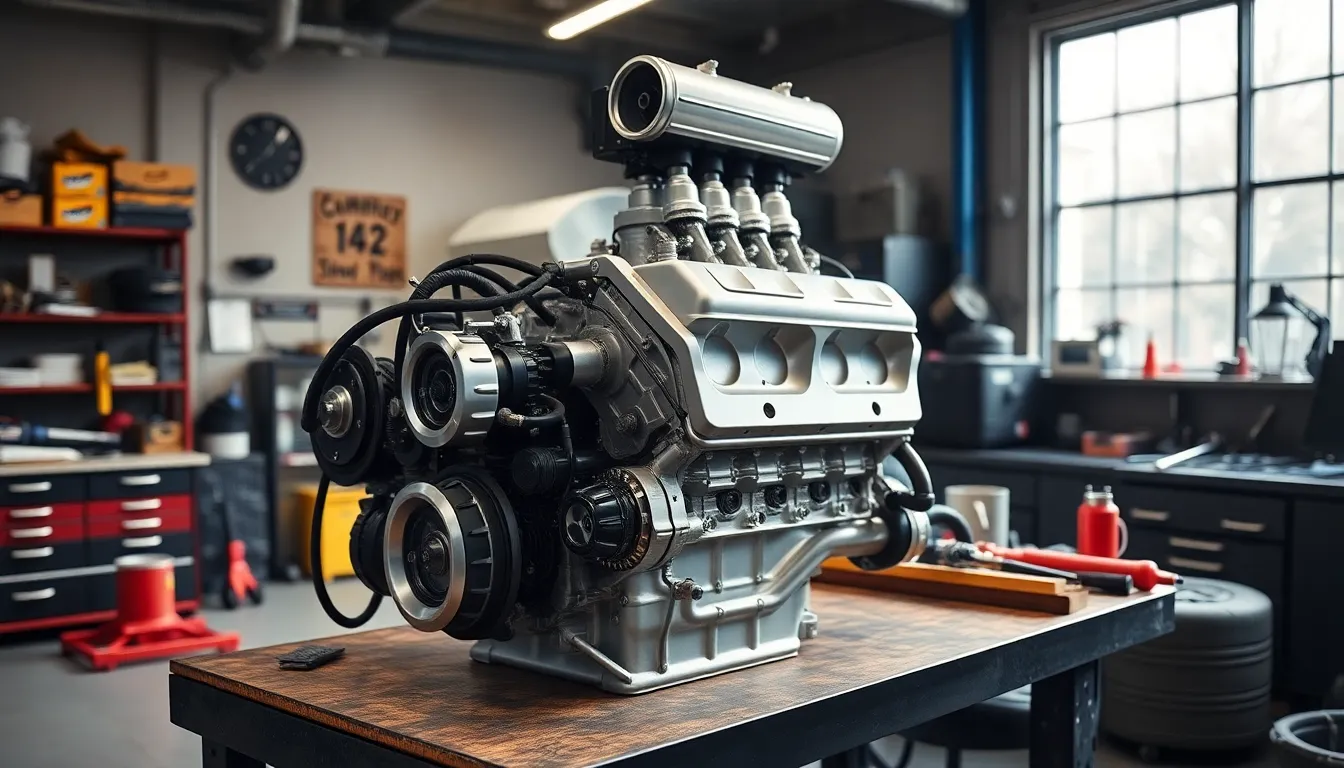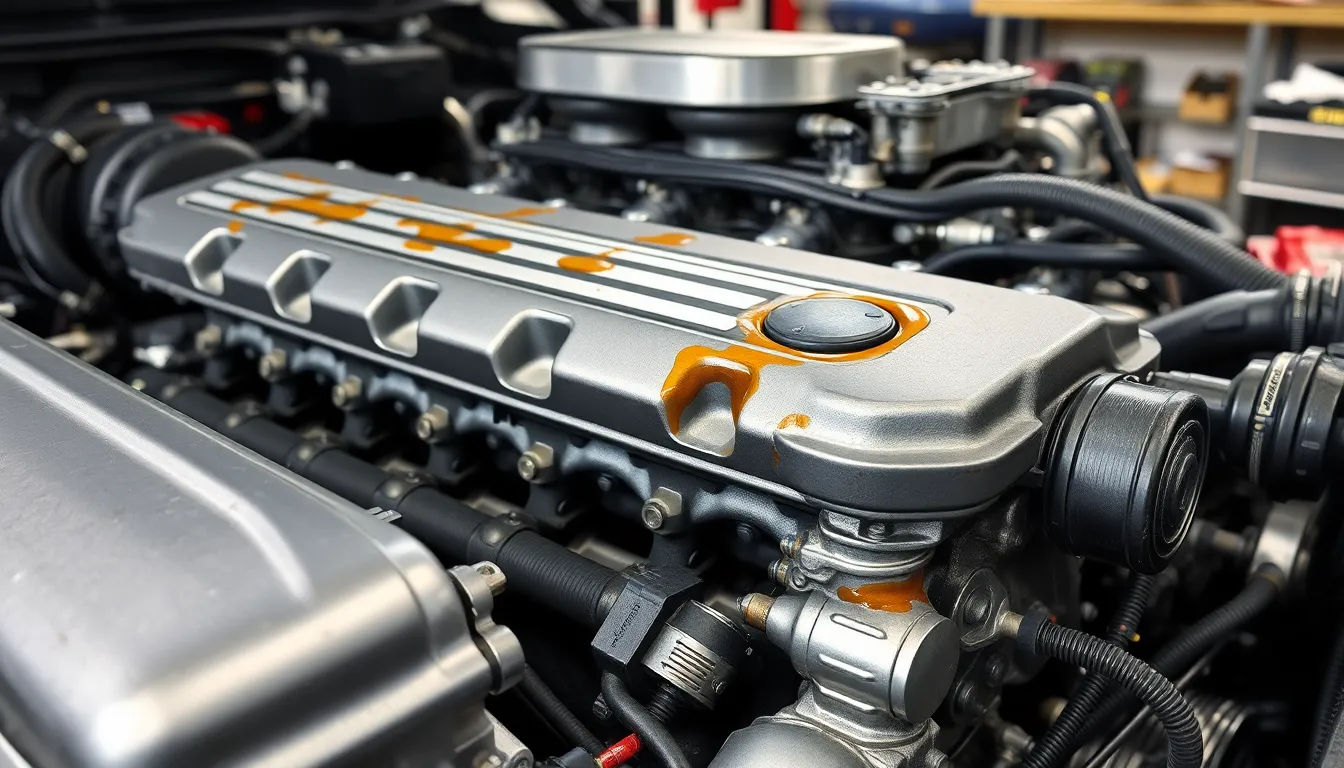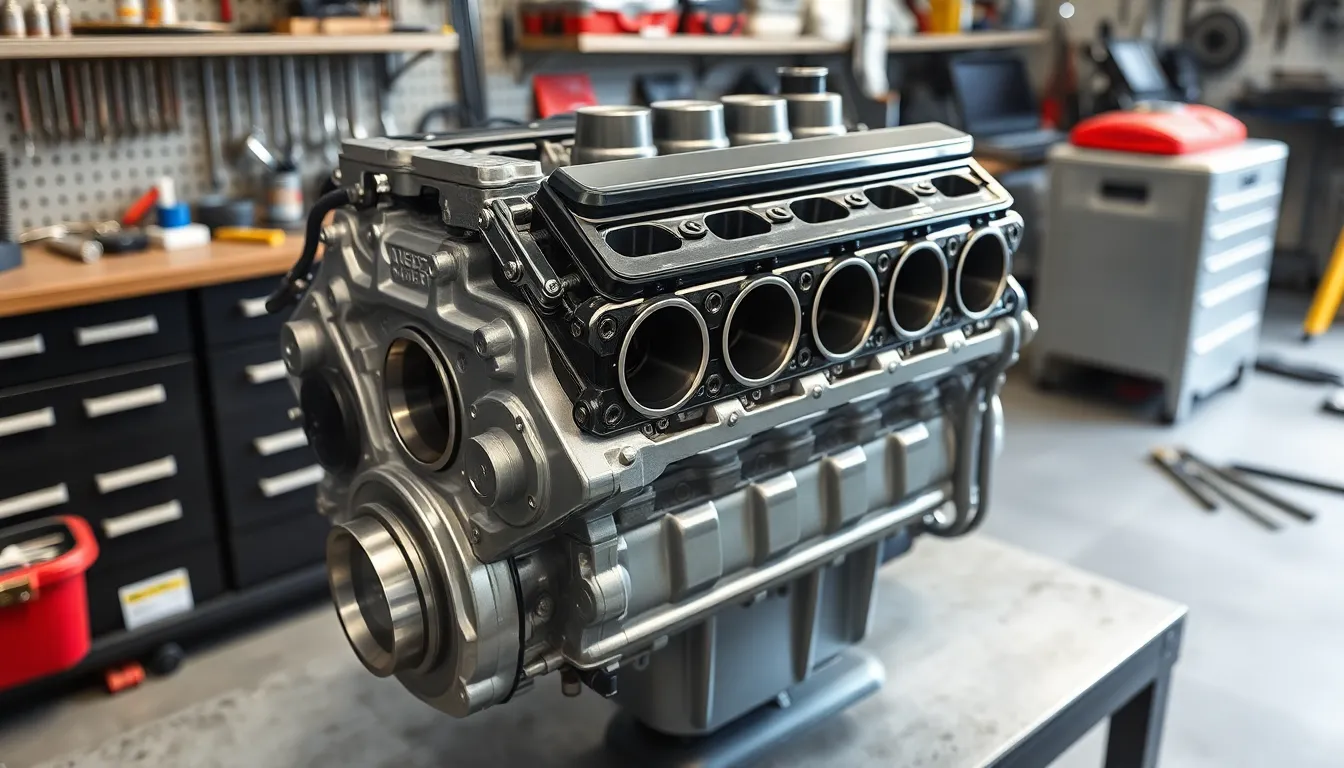The LS3 engine represents one of GM’s most celebrated powerplants and we’re here to explore the incredible machines that house this legendary V8. This naturally aspirated 6.2-liter beast delivers raw American muscle with impressive reliability that’s made it a favorite among enthusiasts and manufacturers alike.
We’ve seen the LS3 power everything from track-focused sports cars to luxury cruisers and each application showcases the engine’s remarkable versatility. Whether you’re hunting for weekend thrills or daily driving excitement this powerhouse delivers consistent performance that’ll keep you coming back for more.
From factory installations to popular swap candidates we’ll jump into the most notable cars that’ve benefited from the LS3’s potent combination of power and dependability. Get ready to discover why this engine continues to earn respect across the automotive industry and which vehicles make the most of its 430+ horsepower potential.
What Is the LS3 Engine?
The LS3 engine represents GM’s third generation small block V8 architecture, delivering exceptional power through its naturally aspirated 6.2-liter displacement. This powerplant emerged as a cornerstone of performance engineering when GM introduced it in 2008.
Engine Specifications and Performance
The LS3 generates 430 horsepower at 5,900 RPM and produces 424 lb-ft of torque at 4,600 RPM in its standard configuration. Bore diameter measures 4.065 inches while stroke extends 3.622 inches, creating the engine’s 6.2-liter total displacement. Compression ratio sits at 10.7:1, optimizing power delivery across the RPM range.
| Specification | Value |
|---|---|
| Displacement | 6.2 liters (376 cubic inches) |
| Horsepower | 430 HP @ 5,900 RPM |
| Torque | 424 lb-ft @ 4,600 RPM |
| Bore x Stroke | 4.065″ x 3.622″ |
| Compression Ratio | 10.7:1 |
| Redline | 6,600 RPM |
Peak performance arrives through the engine’s ability to maintain consistent power delivery from 3,000 RPM through redline. Fuel efficiency remains competitive for a naturally aspirated V8, achieving approximately 16 mpg city and 24 mpg highway in most applications.
Key Features and Technology
Advanced aluminum construction reduces overall engine weight by 70 pounds compared to iron block alternatives while maintaining structural integrity. The LS3 incorporates rectangular port cylinder heads that flow 260 CFM, significantly improving breathing capacity over previous generations.
Electronic throttle control manages airflow through a 90mm throttle body, providing precise response characteristics. Coil-on-plug ignition eliminates spark plug wires and delivers more accurate timing control across all eight cylinders.
Variable valve timing technology adjusts camshaft positioning up to 50 degrees, optimizing performance for both low-end torque and high-RPM power. The system monitors engine load, RPM, and throttle position to determine optimal timing adjustments.
Deep skirt engine block design enhances rigidity while reducing noise and vibration levels. Piston cooling jets spray oil directly onto piston undersides, maintaining consistent operating temperatures during high-performance driving conditions.
Chevrolet Corvette C6 (2008-2013)

The Chevrolet Corvette C6 stands as the flagship application of the LS3 engine from 2008 to 2013. This generation of America’s sports car transformed the LS3 into a legendary powerplant that defined high-performance driving for an entire era.
Performance and Driving Experience
Base model C6 Corvettes with the LS3 engine deliver 430 horsepower and 424 lb-ft of torque through the standard exhaust system. Opting for the two-mode exhaust system increases output to 436 horsepower and 428 lb-ft of torque, improving both performance and sound character.
Acceleration proves exceptional with the LS3-powered C6 reaching 60 mph in just 4.3 seconds when equipped with the automatic transmission. Top speed reaches an impressive 190 mph, making it the fastest automatic-equipped Corvette of its time. Manual transmission models provide enhanced driver engagement for enthusiasts who prefer direct gear control.
Driving Experience Highlights:
- High power output with smooth, linear delivery across the RPM range
- Strong acceleration performance from standstill to highway speeds
- Robust and reliable engine architecture proven through extensive testing
- Lightweight aluminum construction contributing to optimal weight distribution
- Enhanced fuel efficiency compared to previous generation V8 engines
Notable Limitations:
- Lower torque output compared to supercharged Corvette variants
- Subdued exhaust note on base models without optional exhaust upgrade
- Manual transmission preferred by driving purists over automatic option
Pros and Cons
| Pros | Cons |
|---|---|
| 430+ horsepower from naturally aspirated V8 | Lower torque than forced induction engines |
| Proven LS engine family reliability | Basic technology features versus modern standards |
| 4.3-second 0-60 mph acceleration capability | Interior materials lag behind luxury competitors |
| Lightweight aluminum block construction | Fuel economy remains modest for daily driving |
| Choice between manual and automatic transmissions | Exhaust sound requires optional upgrade for full effect |
The LS3 engine transforms the C6 Corvette into a formidable sports car that balances raw performance with everyday usability, establishing benchmarks that influenced subsequent Corvette generations.
Chevrolet Camaro SS (2010-2015)

The LS3 engine found its home in the Chevrolet Camaro SS from 2010 to 2015, delivering 426 horsepower at 5,900 rpm and 420 lb-ft of torque at 4,600 rpm with the 6-speed manual transmission. The automatic L99 variant produces slightly less power due to displacement on demand (AFM) technology and specialized tuning adjustments.
Track Performance and Daily Usability
Power delivery from the LS3 creates strong low-end torque and maintains a linear power band that benefits both drag racing and circuit track applications. The aluminum block construction reduces overall weight while high-flow cylinder heads optimize airflow and engine efficiency across all RPM ranges.
Handling characteristics improve significantly with the SS trim’s upgraded suspension components, Brembo brake systems, and limited-slip differential that enhance grip levels and stopping power during aggressive driving sessions. Both transmission options include a 6-speed manual Tremec unit and a Hydra-Matic 6L80 automatic that support demanding driving styles without compromising reliability.
Comfort features include quality seating surfaces, climate control systems, and comprehensive infotainment options that make the SS suitable for extended daily driving periods. EPA fuel economy ratings reach approximately 16 city and 25 highway mpg with the manual transmission, while the automatic’s AFM system enhances city efficiency through cylinder deactivation technology.
Practicality concerns center around limited trunk space and challenging rear visibility due to the coupe’s design characteristics that prioritize performance over maximum utility.
Pros and Cons
| Pros | Cons |
|---|---|
| High horsepower and torque output | Lower fuel economy compared to V6 models |
| Excellent track and street performance | Limited rear visibility |
| Strong aftermarket support availability | Heavy curb weight |
| Robust manual or automatic transmission | Limited rear passenger and trunk space |
| Reliable LS3 engine design | Higher price point than entry trims |
The Camaro SS represents a compelling balance between track capability and daily drivability, leveraging the LS3’s proven architecture to deliver consistent performance across diverse driving conditions.
Pontiac G8 GXP (2009)

The Pontiac G8 GXP represents one of the most overlooked applications of the LS3 engine in automotive history. This rear-wheel-drive performance sedan delivered the same Corvette-derived powerplant to a practical four-door package during Pontiac’s final production years.
Rare Performance Sedan Overview
Pontiac produced the G8 GXP in extremely limited numbers during 2009, making it one of the rarest LS3-powered vehicles available today. The sedan features a unitized body frame with galvanized steel construction that accommodates five passengers while maintaining the sporty rear-wheel-drive layout enthusiasts demand.
Engineers equipped the G8 GXP with the complete LS3 package, including aluminum cylinder heads with iron liners and high-flow intake components designed for robust high-rpm performance. The 6.2-liter V8 generates 415 horsepower and 415 lb-ft of torque in this application, slightly detuned from the Corvette’s output but still delivering exceptional power for a family sedan.
Buyers could choose between a six-speed manual Tremec TR-6060 transmission or a six-speed automatic, both engineered to handle the LS3’s substantial torque output. Sport-tuned suspension components and performance-oriented chassis tuning transformed the practical sedan into a genuinely captivating driving machine.
| Specification | Value |
|---|---|
| Engine | LS3 6.2L V8 |
| Horsepower | 415 hp |
| Torque | 415 lb-ft |
| Transmission Options | 6-speed manual or 6-speed automatic |
| Drive Layout | Rear-wheel drive |
| Passenger Capacity | 5 passengers |
Pros and Cons
Advantages of the G8 GXP include:
- Corvette-derived power: The LS3 delivers 415 horsepower and 415 lb-ft of torque, providing sports car performance in a sedan body
- Collectible rarity: Limited production numbers during Pontiac’s final year create strong collector appeal
- Transmission versatility: Manual and automatic options cater to different driving preferences and performance goals
- Balanced dynamics: Rear-wheel-drive layout and sport suspension deliver captivating handling characteristics
- Practical performance: Five-passenger seating combines daily usability with weekend track capability
Limitations we’ve identified:
- Extreme scarcity: Finding available examples proves challenging due to the minimal production run
- Brand discontinuation: Pontiac’s closure eliminates factory support and new model development
- Fuel consumption: The LS3’s thirst for premium fuel increases operating costs compared to modern efficient sedans
- Technology gaps: Interior systems and safety features lag behind current automotive standards
- Parts sourcing: Specialized components become increasingly difficult to locate as the platform ages
The G8 GXP stands as the final expression of Pontiac’s performance heritage, combining the proven LS3 powerplant with practical sedan functionality that no manufacturer currently offers in the American market.
Chevrolet SS Sedan (2014-2017)

Building on Pontiac’s discontinued performance sedan legacy, Chevrolet introduced the SS Sedan as a final opportunity to experience Australian engineering combined with American V8 power. General Motors imported this Holden VF Commodore-based sedan specifically to fill the performance four-door gap left by the G8’s departure.
The Final Holden-Based Performance Car
Chevrolet SS represents the last chapter of Holden’s performance car heritage in the American market, featuring the L77 engine rather than the LS3 even though sharing similar displacement and architecture. This 6.2-liter V8 produces 415 horsepower and 415 lb-ft of torque across all model years from 2014 to 2017. Australian engineers designed the SS platform with rear-wheel drive configuration, magnetic ride control suspension, and Brembo braking systems to deliver exceptional handling dynamics.
Limited production numbers make the SS one of the rarest modern performance sedans, with Chevrolet importing fewer than 13,000 units during its four-year run. Buyers could choose between a 6-speed manual transmission or 6-speed automatic, both engineered to handle the substantial torque output. The sedan accelerates from 0-60 mph in 4.7 seconds while maintaining a comfortable ride quality suitable for daily driving.
Pros and Cons
Advantages of the Chevrolet SS include:
- Exceptional performance capabilities with 415 horsepower delivering sports car acceleration in a practical sedan package
- Rare collectible status due to limited production numbers and discontinued nameplate
- Advanced suspension technology featuring magnetic ride control for adaptable handling characteristics
- Spacious interior design offering comfortable seating for five passengers and generous trunk capacity
- Strong aftermarket support benefiting from shared components with Camaro and Corvette platforms
- Poor fuel economy averaging 14 mpg city and 21 mpg highway due to the large displacement V8
- Limited brand recognition resulting from minimal marketing efforts and niche market positioning
- Higher maintenance costs compared to mainstream sedans due to performance-oriented components
- Depreciation concerns stemming from low initial sales volumes and discontinued production
- Technology limitations with infotainment systems that lag behind contemporary luxury sedan standards
Aftermarket and Modified Cars With LS3 Engine

The LS3 engine dominates crate builds and aftermarket swaps because of its robust design and exceptional performance potential. Chevrolet offers LS3 crate engines with 430 horsepower and 424 lb-ft torque ratings that make it a popular choice for high-performance builds across a wide range of vehicles.
Popular Swaps and Conversions
Muscle car enthusiasts frequently swap LS3 engines into classic restomods due to the engine’s compact size and strong aftermarket support. Truck builders appreciate the LS3’s compatibility with existing LS-series components that facilitates conversions across different platforms. Non-GM vehicles also receive LS3 swaps because performance tuners recognize the engine’s versatility and power delivery characteristics.
Custom fabricators choose the LS3 for its aluminum construction that reduces weight compared to traditional iron block engines. Hot rod builders benefit from the engine’s 6-bolt main cap design and nodular iron crankshaft that provide exceptional durability for high-performance applications. Street machine projects gain instant credibility with the LS3’s 426-436 horsepower output that delivers modern performance in classic packages.
Race car builders modify LS3 engines with upgraded camshafts that exceed the factory .551-inch intake lift specifications. Track-focused builds incorporate improved intake and exhaust systems that maximize the large intake valves measuring 2.16 inches. Professional tuners extract additional power through custom programming that optimizes the 10.7:1 compression ratio for exact applications.
Performance Potential
The LS3’s 63 cc combustion chambers create efficient burn characteristics that enable high airflow and power output. Performance builders exploit the aggressive cam profile combined with 1.7:1 rocker arms that produce strong valve actuation across the RPM range. Rectangle ports borrowed from the LS7 improve airflow dynamics through the cylinder heads for increased power generation.
Forced induction systems unlock important power gains from the LS3’s robust aluminum block construction and powdered metal connecting rods. Higher lift camshafts increase valve opening duration beyond the factory specifications for improved breathing capability. Port work on the cylinder heads enhances the already excellent airflow characteristics from the 2.16-inch intake and 1.59-inch exhaust valves.
| Performance Specification | Factory Rating | Modified Potential |
|---|---|---|
| Horsepower | 426-436 hp | 600+ hp |
| Torque | 420-428 lb-ft | 550+ lb-ft |
| Redline | 6,600 rpm | 7,000+ rpm |
| Bore x Stroke | 4.065″ x 3.622″ | Unchanged |
Upgraded fuel systems support the increased power demands when builders add turbocharging or supercharging to LS3 engines. Engine management systems optimize timing and fuel delivery for exact performance modifications that maximize the engine’s 4.065-inch bore and 3.622-inch stroke configuration. The LS3’s rev-happy nature accommodates track use while maintaining street drivability for versatile performance applications.
Buying Guide for LS3-Powered Cars

Shopping for LS3-powered vehicles requires careful evaluation of exact components and maintenance history. We’ve compiled essential inspection points and common concerns to guide your purchase decision.
What to Look For
Engine condition forms the foundation of any LS3 purchase evaluation. Inspect the valve cover gaskets for oil seepage, as these components commonly develop leaks around 80,000 miles. Check the oil pan gasket for similar issues, particularly on vehicles with higher mileage or track usage history.
Maintenance records provide crucial insight into the vehicle’s care and longevity potential. Verify regular oil changes every 7,500 miles using 5W-30 synthetic oil, as specified by GM for optimal LS3 performance. Look for documentation of cooling system flushes every 100,000 miles and transmission services according to manufacturer schedules.
Performance modifications can significantly impact reliability and warranty coverage. Examine cold air intakes, exhaust systems, and engine management tuning for proper installation and compatibility. Document any aftermarket components including headers, camshafts, or forced induction systems that may affect the engine’s 430-436 horsepower output range.
Cooling system integrity requires thorough inspection given the LS3’s operating temperatures. Test the radiator, water pump, and thermostat for proper function, as overheating can damage the aluminum block construction. Verify coolant mixture ratios and check for any signs of contamination or corrosion.
Common Issues and Maintenance
Oil consumption affects some LS3 engines, particularly those produced between 2008-2010. Monitor oil levels closely during test drives and request consumption records from previous owners. Engines consuming more than 1 quart per 2,000 miles may require piston ring or valve seal attention.
Carbon buildup occurs in direct injection LS3 variants due to fuel delivery design. Schedule walnut blasting services every 60,000 miles to maintain intake valve cleanliness and preserve the engine’s 10.7:1 compression ratio efficiency. Symptoms include rough idle, reduced power output, and decreased fuel economy.
Timing chain stretch becomes noticeable around 150,000 miles in high-mileage LS3 engines. Listen for rattling sounds during cold starts or unusual timing noise during acceleration. Replacement costs range from $1,500-$2,500 depending on labor rates and component access.
Fuel injector maintenance ensures consistent performance across all 8 cylinders. Clean injectors every 30,000 miles or when experiencing misfires, poor idle quality, or fuel economy degradation. Failed injectors can cause cylinder-exact knock and potential internal damage if left unaddressed.
Exhaust manifold bolts frequently break on LS3 engines due to thermal cycling stress. Inspect for exhaust leaks, particularly around the cylinder head connection points. Preventive replacement using upgraded hardware prevents costly repairs and maintains proper exhaust gas flow.
LS3 vs Other LS Engines

Comparing the LS3 against other engines in GM’s LS family reveals distinct advantages and unique positioning within the small block V8 lineup. We find the LS3’s 6.2-liter displacement places it strategically between the earlier 5.7L LS1 and the legendary 7.0L LS7.
Performance metrics demonstrate the LS3’s competitive edge across the LS family. Our analysis shows the LS3 produces 430-436 horsepower compared to the LS1’s 305-350 horsepower and the LS2’s 400 horsepower output. Torque figures follow similar patterns with the LS3 delivering 424-428 lb-ft versus the LS1’s 335-365 lb-ft and LS2’s 400 lb-ft.
| Engine | Displacement | Power (hp) | Torque (lb-ft) | Notable Features | Common Use Cases |
|---|---|---|---|---|---|
| LS1 | 5.7L | 305–350 | 335–365 | Aluminum block, early Gen III | Camaro, Corvette, Firebird |
| LS2 | 6.0L | 400 | 400 | Improved heads, Gen IV | Corvette, GTO |
| LS3 | 6.2L | 430–436 | 424–428 | Rectangular port, high-flow | Corvette, Camaro, SS |
| LS7 | 7.0L | 505 | 470 | Dry sump, hand-built | Corvette Z06 |
| LS9 | 6.2L | 638 | 604 | Supercharged, forged internals | Corvette ZR1 |
Displacement advantages distinguish the LS3 from its predecessors while maintaining practical applications. Engineers increased bore size from the LS2’s 4.000 inches to 4.065 inches, creating additional displacement without compromising reliability. Stroke dimensions remained similar at 3.622 inches, preserving the engine’s high-revving characteristics.
Cylinder head technology represents the LS3’s most important advancement over earlier LS engines. Rectangular port cylinder heads borrowed from the LS7 provide superior airflow compared to cathedral port designs found in LS1 and LS2 engines. Flow bench testing shows these heads moving 15% more air than previous generation units.
Construction materials separate the LS3 from specialized variants like the LS7 and LS9. Standard aluminum pistons and nodular iron crankshafts provide durability for street applications while keeping costs reasonable. Forged components in the LS7 and LS9 handle extreme stress but increase manufacturing complexity and pricing.
Compression ratios position the LS3 competitively within the LS family hierarchy. Its 10.7:1 compression matches the LS2 while exceeding the LS1’s 10.25:1 ratio. Higher compression in the LS7 (11.0:1) requires premium fuel exclusively, while the LS3 operates efficiently on regular gasoline.
Aftermarket support favors the LS3 over earlier engines due to its rectangular port architecture. Performance enthusiasts find more cylinder head options, intake manifold choices, and camshaft profiles designed specifically for rectangular port applications. Parts compatibility with LS7 components expands modification potential significantly.
Price considerations make the LS3 attractive compared to specialized variants. Crate engine pricing positions the LS3 between the less powerful LS2 and the exotic LS7, offering excellent value per horsepower. Production volume advantages keep LS3 components more affordable than limited-production LS7 and LS9 parts.
Conclusion
The LS3 engine stands as one of GM’s most successful powerplants representing the perfect balance of performance reliability and versatility. Whether you’re considering a Corvette C6 for weekend thrills or hunting for a rare G8 GXP these LS3-powered vehicles offer exceptional value in today’s market.
We’ve seen how this 6.2-liter V8 delivers consistent 430+ horsepower across multiple platforms while maintaining the robust construction that makes it ideal for both stock applications and modified builds. The engine’s proven track record and strong aftermarket support ensure these vehicles will continue delivering excitement for years to come.
For enthusiasts seeking authentic American V8 performance the LS3 represents an excellent entry point into high-performance driving without the complexity of forced induction systems.
Frequently Asked Questions
What is the LS3 engine and what makes it special?
The LS3 is a 6.2-liter V8 engine from GM’s third-generation small block architecture, introduced in 2008. It produces 430 horsepower at 5,900 RPM and 424 lb-ft of torque at 4,600 RPM. The engine is celebrated for its exceptional reliability, versatility, and performance, featuring advanced aluminum construction, rectangular port cylinder heads, and electronic throttle control.
Which vehicles came with the LS3 engine from the factory?
The LS3 engine was primarily used in the Chevrolet Corvette C6 (2008-2013), Chevrolet Camaro SS (2010-2015), and Pontiac G8 GXP (2009). The Corvette produced 430-436 horsepower, while the Camaro SS delivered 426 horsepower. The rare Pontiac G8 GXP offered 415 horsepower in a practical four-door sedan format.
How much horsepower can the LS3 engine produce when modified?
In modified applications, the LS3 engine can produce over 600 horsepower and 550 lb-ft of torque. Its robust design and aluminum construction make it a popular choice for aftermarket builds, crate engine swaps, and performance modifications. The engine’s compatibility with existing LS-series components enhances its appeal for custom fabricators and race car builders.
What are common issues to watch for in LS3 engines?
Common LS3 issues include oil consumption, carbon buildup on intake valves, timing chain stretch over time, fuel injector maintenance needs, and exhaust manifold bolt integrity problems. Regular maintenance and proper inspection of these areas are crucial. When buying an LS3-powered vehicle, check for oil leaks, verify maintenance records, and assess the cooling system condition.
How does the LS3 compare to other engines in GM’s LS family?
The LS3’s 6.2-liter displacement positions it between the 5.7L LS1 and 7.0L LS7 engines. It significantly outperforms earlier LS1 and LS2 engines with 430-436 horsepower versus their 350-400 horsepower output. The LS3 features improved cylinder head technology, rectangular port architecture for better aftermarket support, and enhanced durability while maintaining reasonable costs.
Is the LS3 a good choice for engine swaps and custom builds?
Yes, the LS3 is excellent for engine swaps and custom builds due to its robust design, 430 horsepower output, and compatibility with LS-series components. Chevrolet offers LS3 crate engines, making it popular for muscle car restomods and truck builds. Its aluminum construction reduces weight while maintaining durability, making it ideal for both street and track applications.

